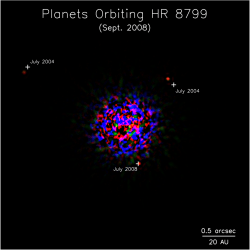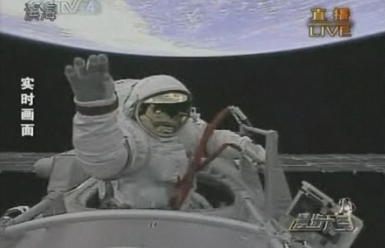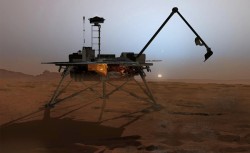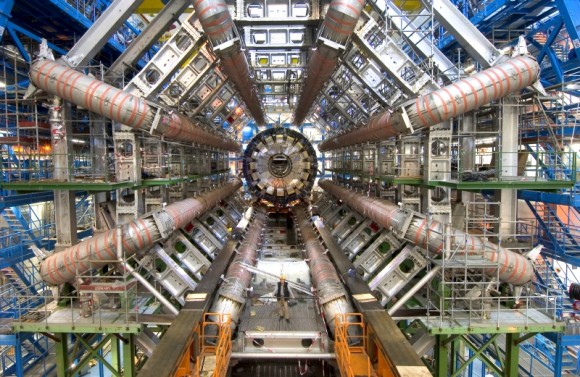[/caption]2008 has been an astounding year of scientific discovery. To celebrate this fact, Time Magazine has listed the “Top 10 Scientific Discoveries” where space exploration and physics dominate. Other disciplines are also listed; including zoology, microbiology, technology and biochemistry, but the number 1 slot goes to the most ambitious physics experiment of our time. Can you guess what it is? Also, of all our endeavours in space, can you pick out three that Time Magazine has singled out as being the most important?
As we approach the end of the year, ready to welcome in 2009, it is good to take stock and celebrate the mind-blowing achievements mankind has accomplished. Read on for the top 10 scientific discoveries of 2008…
The best thing about writing for a leading space news blog is that you gain wonderful overview to all our endeavours in astronomy, space flight, physics, politics (yes, space exploration has everything to do with politics), space commercialization and science in general. 2008 has been such a rich year for space exploration; we’ve landed probes on other worlds, studied other worlds orbiting distant stars, peered deep into the quantum world, learnt profound things about our own planet, developed cutting-edge instrumentation and redefined the human existence in the cosmos. We might not have all the answers (in fact, I think we are only just beginning to scratch the surface of our understanding of the Universe), but we have embarked on an enlightening journey on which we hope to build strong foundations for the next year of scientific discovery.
In an effort to assemble some of the most profound scientific endeavours of this year, Time Magazine has somehow narrowed the focus down to just 10 discoveries. Out of the ten, four are space and physics related, so here they are:
6. Brave New Worlds: First direct observations of exoplanets

Considering there have never been any direct observations of exoplanets before November 2008–although we have known about the presence of worlds orbiting other stars for many years via indirect methods–this has been a revolutionary year for exoplanet hunters.
4. China Soars into Space: First taikonaut carries out successful spacewalk

Despite early controversy surrounding recorded spaceship transmissions before the rocket had even launched, and then the sustained efforts by conspiracy theorists to convince the world that the whole thing was staged, mission commander Zhai Zhigang did indeed become the first ever Chinese citizen to carry out a spacewalk. Zhai spent 16 minutes outside of the capsule, attached by an umbilical cable, to triumphantly wave the Chinese flag and retrieve a test sample of solid lubricant attached to the outside of the module. His crew mate Liu Boming was also able to do some spacewalking.
Probably the most incredible thing about the first Chinese spacewalk wasn’t necessarily the spacewalk itself, it was the speed at which China managed to achieve this goal in such a short space of time. The first one-man mission into space was in 2003, the second in 2005, and the third was this year. Getting man into space is no easy task, to build an entire manned program in such a short space of time, from the ground-up, is an outstanding achievement.
2. The North Pole – of Mars: The Phoenix Mars Lander

During the few weeks on Mars, Phoenix discovered water, studied atmospheric phenomena, plus it characterized the regolith to find it is more “soil-like” than we gave it credit for. However, Phoenix also discovered a chemical called perchlorate that could be hazardous to life on the Martian surface, but there is a flip-side to that coin; the chemical may provide energy for basic forms of life.
Like all good adventures there were twists and turns in Phoenix’s progress, with the odd conspiracy thrown in for good measure. Even during Phoenix’s sad, slow death, the lander had some surprises in store before it slowly slipped into a Sun-deprived, low energy coma.
To give the highly communicative lander the last word, MarsPhoenix on Twitter has recently announced: “Look who made Time Mag’s Top 10 list for Scientific Discoveries in 2008: http://tinyurl.com/5mwt2l”
1. Large Hadron Collider

Speaking of “capturing the hearts and minds” of the world, the Large Hadron Collider (LHC) has done just that, but not always in a positive way (although common sense seems to be winning). So, in the #1 spot of Time Magazine’s Top 10 Scientific Discoveries of 2008, the LHC is a clear winner.
In the run-up to the switch-on of the LHC in September, the world’s media focused its attention on the grandest physics experiment ever constructed. The LHC will ultimately probe deep into the world of subatomic particles to help to explain some of the fundamental questions of our Universe. Primarily, the LHC has been designed to hunt for the elusive Higgs boson, but the quest will influence many facets of science. From designing an ultra-fast method of data transmission to unfolding the theoretical microscopic dimensions curled up in space-time, the LHC is a diverse science, with applications we won’t fully appreciate for many years.
Unfortunately, as you may be wondering, the LHC hasn’t actually discovered anything yet, but the high-energy collisions of protons and other, larger subatomic particles, will revolutionize physics. I’d argue that the simple fact the multi-billion euro machine has been built is a discovery of how advanced our technological ability is becoming.
Although the first particles were circulated on that historic day on September 10th, we’ll have to wait for the first particle collisions to occur some time in the summer of 2009. Engineers are currently working hard to repair the estimated £14 million (~$20 million) damage caused by the “quench” that knocked out a number of superconducting electromagnets on September 19th.
For more, check out the Top 10 Scientific Discoveries in Time Magazine, there’s another six that aren’t related to space or physics


OK, read “achievements” instead of “discoveries” and then we’ll be groovy 🙂
I was uncertain about the Time article too, but I was just pleased to see #1: Physics, #2 Mars, #4 Space and #6 Astronomy. This is key here – look at what we’ve achieved in only 12 months!
@Joe:- I’ll check out that Space.com article… sounds intriguing 🙂
@Kevin:- To be honest, I’m not certain whether Time Mag got confused about what “discovery” actually means. You’re right, the announcement this week about the supermassive black hole was pretty groundbreaking. But then there are other endeavours that certainly warrant a mention. What about SpaceX – the first commercial space vehicle to be launched into orbit, or rovers Spirit and Opportunity (what an astounding mission), or the first ever asteroid to be observed before it hit Earth (the Sudanese impact)…. the list is endless.
Hmmm, I might do an alternative list 🙂
I’m just going nuts here. I have a saved picture from a few years ago of what “might be” the first picture of an exoplanet. It’s an infared image, so maybe that’s why they’re not counting it. But I never heard a refute on that. Does anybody remember the photo I’m talking about?
Why are these called discoveries?? Instead of achievements??
Did we not know that Mars had a pole?
the LHC? Did we happen upon china in space??
what
Ian, I wish you or Nancy would Blog about an articlee I just read on Space.com talking about how near stellar fly-bys to our solar system disrupt the Oort cloud possibly sending commets our way. The authors talked about fly-bys of 100,000 AU, and disruptive fly-bys of just 10,000 AU (about every 100 million years. Give me a break; we have a star passing our solar system between .2 and 1.5 light years? The nearest star is 4.2 light years right now, and its going to pass through the Oort Cloud? No.
I think the 16-year “stars orbiting the black hole” project may surpass all of these for stunning quality/quantity of results.
Do it, Ian. This site has written about so much cool stuff this year its like the list needs to be a factor of 10. Top Ten lists have always represented something like 10 ideas/facts/ accomplishments out of a 100, or so. Because we’re talking about the most impactful of maybe thousands of valuable (and publishable) accomplishments (engineering) and discoveries (science) these recent years, we should be talking about definitions for the top 10 degrees of impactfulness, and list them all where they line up, with a top ten in each category.
Hell yeah Ian – but do a top 20 for a more comprehensive overview.
Universe Today’s Top 20 Astronomical & Related Discoveries/Achievements of 2008 – should become an annual thing… All the UT contributors could have a little get together and voting session, and then do a big article on it. Then you could put them up for a vote on the site to reveal the popular choice awards from UT readers.
That’d be rad, and I reserve the word rad for only the very raddest things.
I think #7 should have been mentioned here as well. Especially since Universetoday published an article on this as well. If I can remember correctly it was called Warp Drives and Cloaking Devices 😉
Cheers,
Chris
If I had known that one could discover exoplanets by looking into the eye of Sauron I would have stopped being good a long time ago!
The LHC? For heaven’s sake.
We all want to be inspired but the darn thing is still busted.
The only black hole created is where all the funding for it is going.
Proof positive we live in a world where one need achieve nor produce little or nothing and still garner respect and accolade.
The silly season continues.
thXx keeeeeewL!L!!
I think any list is going to be challenged, especially when we have such a diverse range of achievements, discoveries and failures to chose from. I think a UT list of some type would be brilliant, and then every number would relate to physics and astronomy without pesky bacterium, invisibility cloaks and stone age skeletons getting in the way !!
Cheers,
al.
I think this is rather a partial list.
I think instead of China space walk, Chandrayaan was bigger achievement as it was the first mission to moon by India and it was successful. It is also regarded as the cheapest mission by all standards.
Indeed, the world of science and technology is very amazing.
Nice list. I’m very much impress with the LHC. Can’t wait to know its discovery in the near future.
Please always send me the latest discoveries
I am very happy to give a larg number of space discoveries. specialy works of HST
?????. ???????? ? ?????????, ? ?????? ???????? ? ??? ????